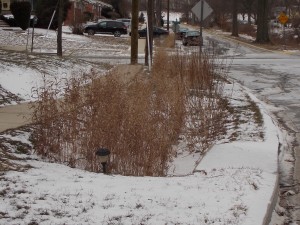Photo credit: Alison Gillespie
There are many myths about green infrastructure – and many good counterarguments. One of the most persistent myths is that Canada’s winter weather makes green infrastructure impractical. We hear it all the time: “This might work in temperate climates in Europe or the U.S. But we have winter!”
This argument is not supported by the evidence.
Some of the most progressive cities that rely on green infrastructure for stormwater management have harsh winters. Milwaukee, Wisconsin has a very ambitious green infrastructure program – and also gets more snow on average each year than Toronto.
The State of Minnesota is another green infrastructure leader that experiences far colder temperatures than most of southern Ontario. (The average temperature in January in at least nine Minnesota cities reaches below minus 10 degrees C.)
Green infrastructure has some advantages over grey in winter weather. Directing roof runoff to permeable areas and using permeable pavement means that less water flows over hard surfaces, resulting in fewer icing hazards, since water does not sit on the pavement. It can also reduce the need for road salt.
Concerns about frozen ground and spring rainfall causing flooding of green infrastructure installations have not been realized. Monitoring of permeable pavement, infiltration trenches and bioretention in winter and spring conditions have consistently shown continued good performance (see for example the Elm Drive monitoring report from CVC and Evaluating permeable pavements in cold climates by TRCA).
Good design can facilitate winter operations and maintenance. Rain gardens and permeable pavement should not be used for snow storage as this may affect performance. Plants that receive runoff from roads, sidewalks, and parking areas should be selected for salt-tolerance. Permeable pavements can get clogged if sand is applied as a de-icer.
Road salt is one of the major pollutants found in stormwater runoff, and because it is soluble in water green infrastructure measures are ineffective at removing it through filtration. This has been used as an argument against infiltration systems in areas with sensitive groundwater resources where road salt is applied.
However, stormwater ponds do not treat road salt either – in fact, they have been found to discharge salty water all year round. So whether runoff is infiltrated into the ground or discharged into surface water, salt ends up in the environment. A new study out of Michigan has linked heavily salted source waters to increased levels of lead in drinking water in Flint.
Pollution prevention is the only way to reduce the risks from road salt. Smart about Salt is a non-profit organization devoted to training and certifying contractors and property managers on salt management to maximize safety while protecting the environment. The Region of Waterloo requires all its contractors to be certified Smart about Salt. A 2010 study which monitored groundwater wells before and after the implementation of salt application best management practices in Waterloo Region found that chloride concentrations were reduced by about 50%.
Winter poses a challenge for all stormwater infrastructure – one of the causes of flooding in spring are storm drains that are blocked with snow and ice. But winter does not need to be a deal-breaker for the use of green infrastructure.
This article was published in The Umbrella Stormwater Bulletin Issue #39.
Poll
Do you believe green infrastructure can work in winter climates?
- Yes – if properly designed and maintained (94%, 31 Votes)
- No – it’s impossible! (6%, 2 Votes)
- Maybe - depends on the technology (0%, 0 Votes)
Total Voters: 33


